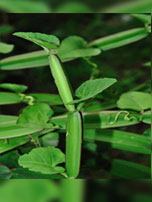Ashtisrinkhala

Botanical Name : Cissus quadrangularis Linn.
Family : Vitaceae
Introduction :
Latin name : cissus — intruns; quadriangularis quadri four, the stalk has 4 edges.
Nowadays this plant is using very much to heal bone fracture.
Names in different Indian languages :
English : Square Stalked Vine,Adamant Creeper
Hindi : Hadjob ,hadjora
Kannada : Mangarahalli
Malayalam : Changalamparanda, perenta
Sanskrit : Ashtisrinkhala
Tamil : Pirantai,vajjravalli
Telugu : Nalleru,nulleratiga
Unani : Hadjod
Synonyms :
Asthisamhaara, Asthisamhrita. Asthi-samyojaka, Vajravalli, Chaturdhaaraa
Vitis quadrangularis Wall
Morphology :
It is a creeper having green and quadrangular stalk which have nodes in between, Therefore it looks like a chain.
Leaves — small, divided into 3 to S parts and have serrated margins, flowers — white with a hairy appearance,
Fruits — round and red, If it is bent into the ground, it grows,
Distribution & Habitat :
Throughout India
Chemical constituents :
phytogenic steroid, ketosteroids, sitosterol, alphaamyrin, alpha-ampyrone , tetracyclic triterpenoids, vitamin C
Properties :
Guna : laghu, ruksha;
Rasa : madhur;
Vipaka : amla;
Veerya , : ushna;
Karma : Deepana, pachan, sulaghna, kandu Fracture healing , carminative, digestive,astingent
Indication :
Pliha roga, agnimandya, sula, gudakeelaka, apsmaram, vata roga, dusta vrana, gulma
irregular menstruation, scurvy
Part used : Whole plant
Dosage :
Leaf juice 10-15 ml
Powder 2-4 g
Decoction 50-100 ml
External uses :
External uses : It has haemostatic and joining properties, In bone fractures, it is applied locally or its oil is applied, In nasal bleeding, its juice is used as nasal drops
Internal uses :
In bone fractures its juice is given orally ( unite the bones faster.)